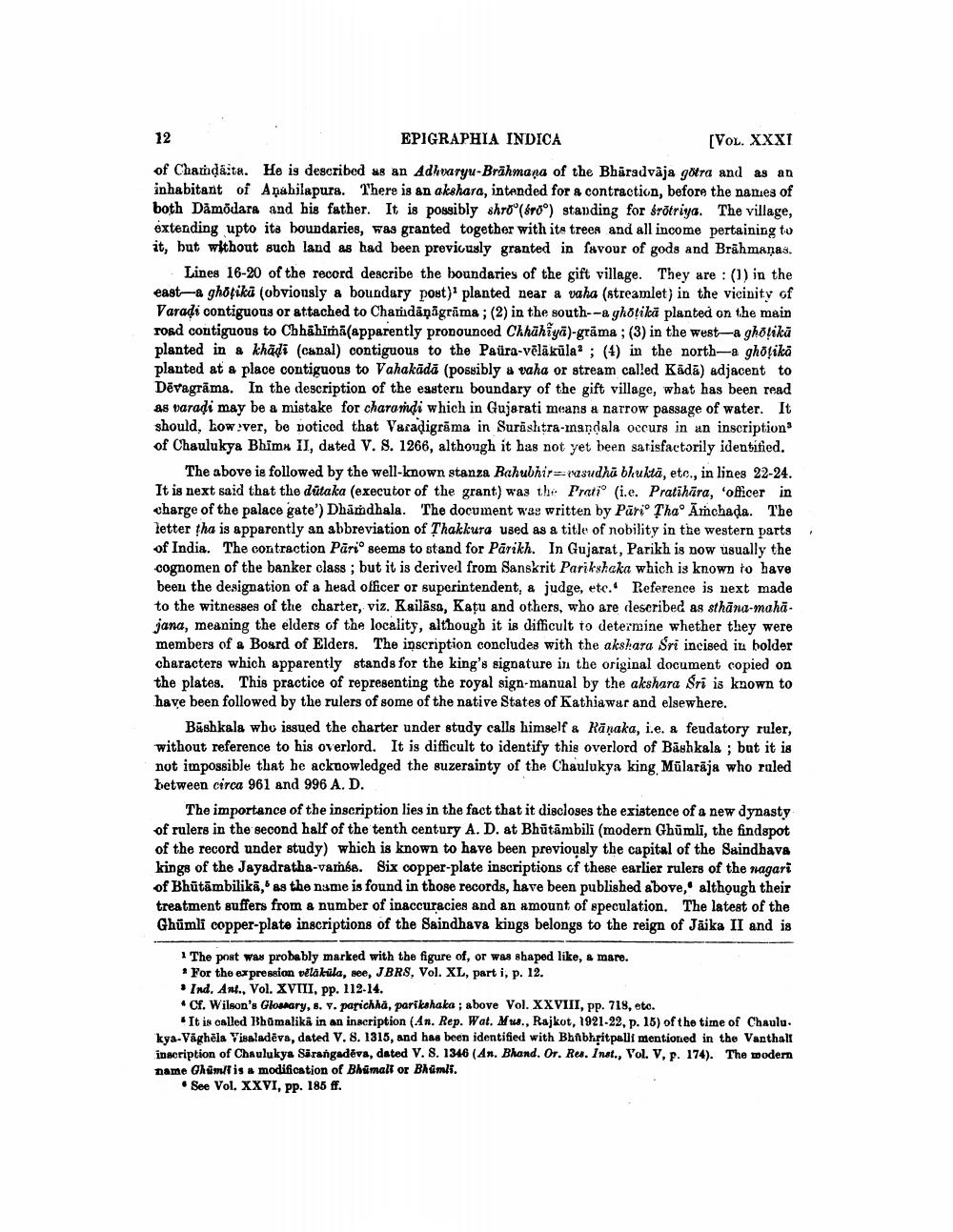________________
12
EPIGRAPHIA INDICA
[VOL. XXXI of Chaxidáita. He is described as an Adlivaryu-Brāhmaṇa of the Bharadvaja götra and as an inhabitant of Anahilapura. There is an akshara, intended for a contraction, before the nanies of both Dämödara and his father. It is possibly shroo(6r0°) standing for frötriya. The village, extending upto its boundaries, was granted together with its trees and all income pertaining to it, but without such land as had been previously granted in favour of gods and Brāhmaṇas.
Lines 16-20 of the record describe the boundaries of the gift village. They are: (1) in the east-a ghoţiku (obviously a boundary post) planted near a vaha (streamlet) in the vicinity of Varadi contiguous or attached to Chamdāņāgrāma; (2) in the south--a ghotikā planted on the main road contiguous to Chhāhimi(apparently pronounced Chhāhiya)-grāma; (3) in the west-a gholikā planted in & khädi (canal) contiguous to the Paüra-vēläküla? ; (4) in the north-a ghoţikā planted at a place contiguous to Vahakādā (possibly a vaha or stream called Kādā) adjacent to Dēvagrāma. In the description of the easteru boundary of the gift village, what has been read as varadi may be a mistake for charandi which in Gujarati means a narrow passage of water. It should, how ver, be noticod that Varadigrāma in Surishtra-inandala occurs in an inscription of Chaulukya Bhimu II, dated V. S. 1266, although it has not yet been satisfactorily identified.
The above is followed by the well-known stanza Bahubhir=-wasudha bhukta, etc., in lines 22-24. It is next said that the dutaka (executor of the grant) was the Pratio i.e. Pratihāra, officer in charge of the palace gate') Dhāmdhala. The document was written by Pūrio Thao Archada. The letter tha is apparently an abbreviation of Thakkura used as a title of nobility in the western parts of India. The contraction Pārio seems to stand for Pārikh. In Gujarat, Parikh is now usually the cognomen of the banker class; but it is derived from Sanskrit Parikshaka which is known to have been the designation of a head officer or superintendent, a judge, etc. Reference is next made to the witnesses of the charter, viz. Kailasa, Kațu and others, who are described as sthāna-mahā. jana, meaning the elders of the locality, although it is difficult to determine whether they were members of a Board of Elders. The inscription concludes with the akshara Sri incised in bolder characters which apparently stands for the king's signature in the original document copied on the plates. This practice of representing the royal sign-manual by the akshara Sri is known to have been followed by the rulers of some of the native States of Kathiawar and elsewhere.
Bashkala who issued the charter under study calls himself & Ränaka, i.e. a feudatory ruler, without reference to his overlord. It is difficult to identify this overlord of Bāshkala ; but it is not impossible that he acknowledged the suzerainty of the Chaulukya king. Mūlarāja who ruled between circa 961 and 996 A. D.
The importance of the inscription lies in the fact that it discloses the existence of a new dynasty of rulers in the second half of the tenth century A.D. at Bhūtāmbili (modern Ghümli, the findspot of the record under study) which is known to have been previously the capital of the Saindhava kings of the Jayadratha-vambe. Six copper-plate inscriptions of these earlier rulers of the nagari of Bhūtāmbilikā,' as the name is found in those records, have been published above, although their treatment suffers from a number of inaccuracies and an amount of speculation. The latest of the Ghümli copper-plate inscriptions of the Saindhava kings belongs to the reign of Jäika II and is
1 The post was probably marked with the figure of, or was shaped like, a mare. * For the expression velākila, see, JBRS, Vol. XL, part i, p. 12. • Ind. Ant., Vol. XVIII, pp. 112-14. • Cf. Wilson's Glosaary, 8. v. parichha, parikshaka; above Vol. XXVIII, pp. 718, etc.
It is called Bhūmalika in an inscription (.4n. Rep. Wat, M ., Rajkot, 1921-22, p. 15) of the time of Chaulu. kya-Väghēla Visaladēva, dated V. 8. 1315, and has been identified with Bhabhritpalli mentioned in the Vanthalt inscription of Chaulukya Sarangadēva, dated V. S. 1346 (An. Bhand. Or. Res. Inst., Vol. V, p. 174). The modern name Chim/t is a modification of Bhimali or Bhimli.
• See Vol. XXVI, pp. 185 ff.




